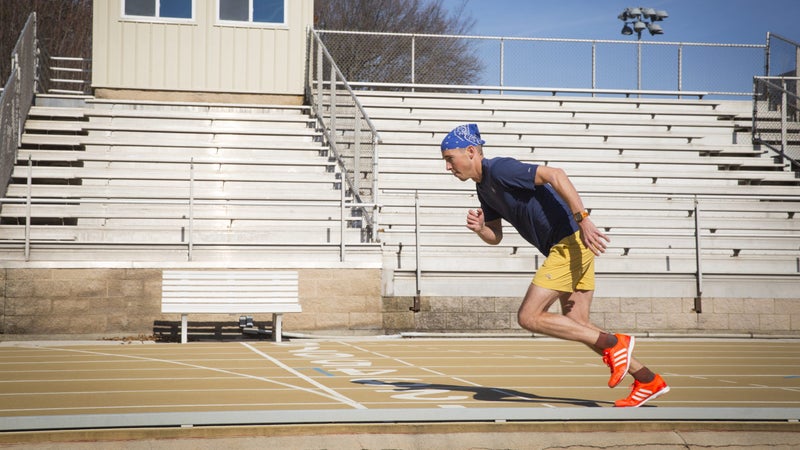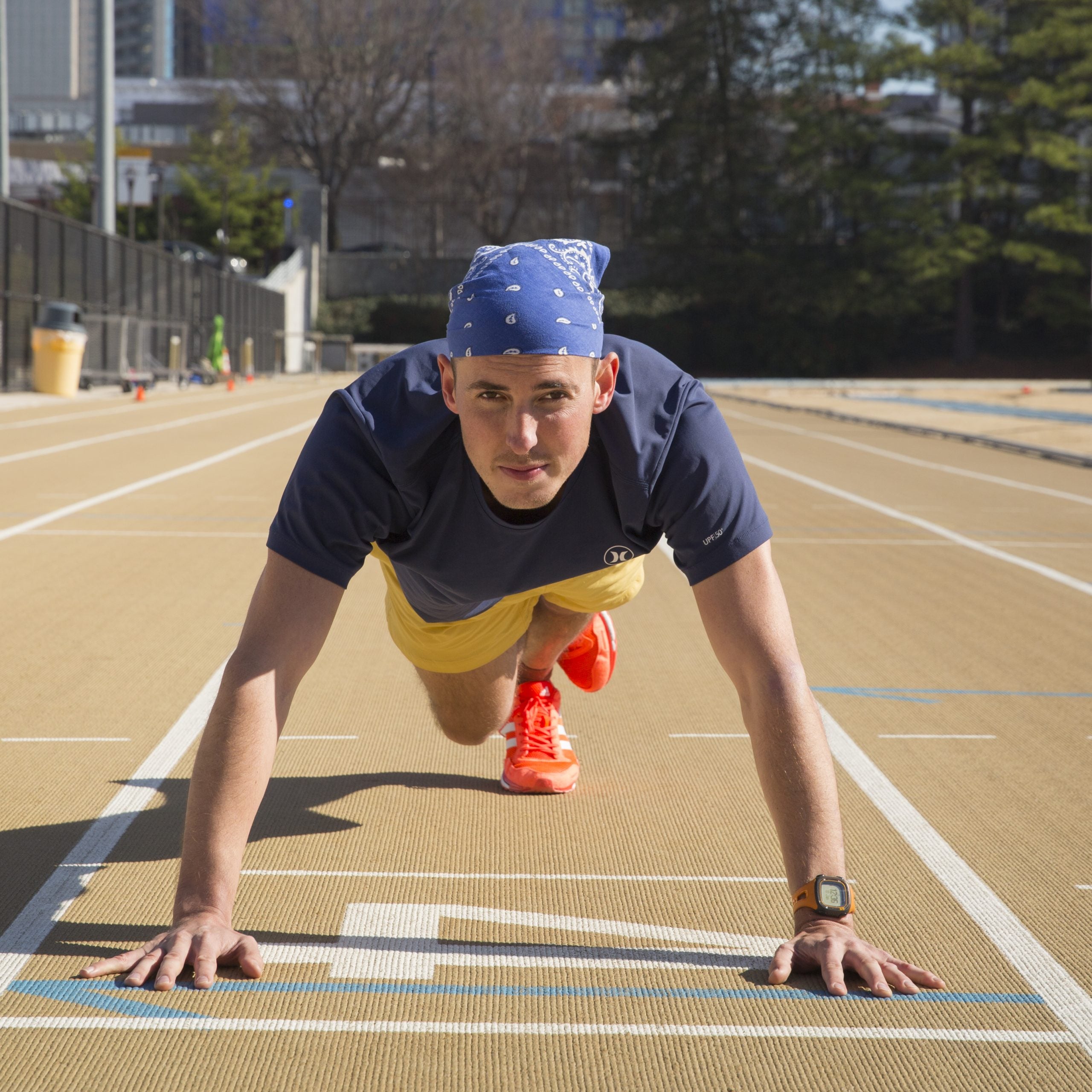I was watching the 1,500-meter Olympic final last summer at a bar, a few months before my 35th birthday, when I first wondered if a middle-distance runner lurked within. It was a strange thought. At six-foot-three and 175 pounds, I have the look of a runner but not the legs. In my early thirties, some half-assed training led to an unimpressive 22:39 5K, a 1:49 half marathon, and an almost four-hour marathon. Usually, it was a girlfriend who’d goaded me into racing. Now, in my mid-thirties, I was managing bad back pain.
Still, the mile intrigued me. It sounded short, simple. Training would take much less time than distance racing (or so I assumed). And everyone runs a marathon these days, right?
I’d never run a timed mile. Never even been on a track. My personal best in the 5K suggested that a 6:30 mile was possible, but that time would be nothing to brag about.
Sub-six seemed too pedestrian, 5:30 too random. Hicham El Guerrouj’s 3:43 world record, set in 1999, was safely out of reach. I decided to go for a sub-five-minute mile. More than 23,000 high-schoolers break five minutes annually. But at twice their age, I’d be OK with that company.
On an early August morning, at a track near my home in Atlanta, I laced up my cushiony New Balances and managed four very tiring, uneven laps in 6:19. Not bad, I thought, sprawled on the grass. But what now? A former college miler told me to “train until you can click off 74-second 400’s in your sleep.”
Atlanta is miserably hot in summer, so I began by running my 400’s (a quarter-mile, usually done as one lap around the track) on a treadmill. I set it at 12 miles per hour—a five-minute-mile pace—and tried to hang on for a minute and 14 seconds. I could soon manage one of those. But it was a couple of months before I could reliably run four in a workout. And that was with rest in between.
By early winter, I’d lost what little fat reserves I’d had and gained some confidence and stamina. I could knock out a tough 2:30 half-mile on the machine. On a chilly mid-November day, I went for it at the same track as my first time trial. My buddy Will, who set our high school 5K record (16:20) 17 years and 30 pounds ago, joined. As did our fit, 28-year-old pal Wyatt, who attempts a sub-five mile annually.
I went out hard, leading the first 400 in 66 seconds (a 4:24-mile pace!) and the second in 73 (still sub-five pace!) before dropping off precipitously as lactic acid filled my over-eager legs. I fell across the finish line, 16 seconds behind Wyatt, in 5:15. Will lumbered in a half-minute later. I could barely stand afterward and coughed for days.

I’d shaved a minute from my mile time in three and a half months, but it was clear that I needed help to get over the edge. Luckily, , the two-time 1,500-meter Olympic medalist from New Zealand who won bronze in the very Rio race that spurred my quest, agreed to coach me. He’d just debuted an online mile-training boot camp called . He devised a five-week plan for me, involving four weeks of training—two focused primarily on endurance, two on speed—and a final week with two shots at my goal.
There was good news. Racing flats, Willis said, would cut three or four seconds off my time. At his suggestion, I ordered some fancy . Willis told me that the blazing first lap of my 5:15, inadvisable as it had been, was proof that I had the necessary speed to pull off a sub-five, assuming I learned how to pace myself. The bad news, he went on, was that I needed to run a lot more, around 30 miles per week to build strength. Running too little is a common mistake that novice runners of all stripes make, but milers in particular are prone to the misstep.
“Do you think I’m too old to pull this off?” I asked him.
“The prevailing wisdom has long been that you’re best in your mid-twenties,” Willis said. “But there’s been a real trend in the last decade of people pushing those boundaries.” In other words, my age was no excuse.
I kept carefully to his plan, which included easy five-mile jogs twice a week, a weekly ten-mile run, a three-mile tempo run at a 6:15 pace, hill intervals, and 100- and 200-meter sprints. Despite eating four or five meals a day, I dropped down to 166 pounds. With Willis’s sign-off, I set an early-January goal date.
Buzzed on coffee and feeling nerves, I arrived at a local high school track on a cloudy afternoon. I’d listened to an R. L. Burnside song with a hypnotic groove that morning, and I tried staying in it as I jogged a warm-up mile. Knowing my tendency to start too hard, Willis had told me to shoot for a more relaxed first lap and steadiness throughout, aiming to make my last lap the fastest.
I contained myself on the first lap. Seventy-six seconds. Then 73, and another 76. By the end of the third lap, my legs felt the telltale weight of lactic acid approaching as I hugged the inside lane. I could taste the metallic flavor of blood in my throat. I strained to breathe. But I knew I was just over a minute away from my goal.
Coming into the final straightaway, according to an amused spectator, I was making audible grunting noises and looked “a little deranged.” I didn’t care. With the last of my energy, I lunged across the finish line and pressed stop on my watch: 4:59:4. Maybe it was the endorphins, but I swear I heard 23,000 high school kids cheering.
The Fast Lane
Whether you’re trying to run under five minutes in the mile, PR at a half marathon, or just finish your first 10K, most new runners make the same mistakes. Here, Olympian and coach Nick Willis tells you how to avoid them.
The Problem: Not running enough.
The Solution: If you want to get close to your potential, or at least enjoy race day, work up to at least 30 miles a week. This is true even for relatively short events like the 5K. To be competitive, you need to increase your volume even further, to about 70 miles a week.
The Problem: Too many runs at race pace.
The Solution: To build a strong fitness baseline, do most of your workouts at a relaxed pace. A good rule of thumb: 80 percent of your runs should be easy, and the other 20 percent should be hard tempo runs, sprints, or hill work.
The Problem: Starting too fast.
The Solution: To avoid a spectacular blow-up in the back half of any race, you need to run at a consistent pace. “You have to develop this judgment in training,” says Willis. Come race day, you’ll likely be so eager that you have to consciously hold yourself back.


